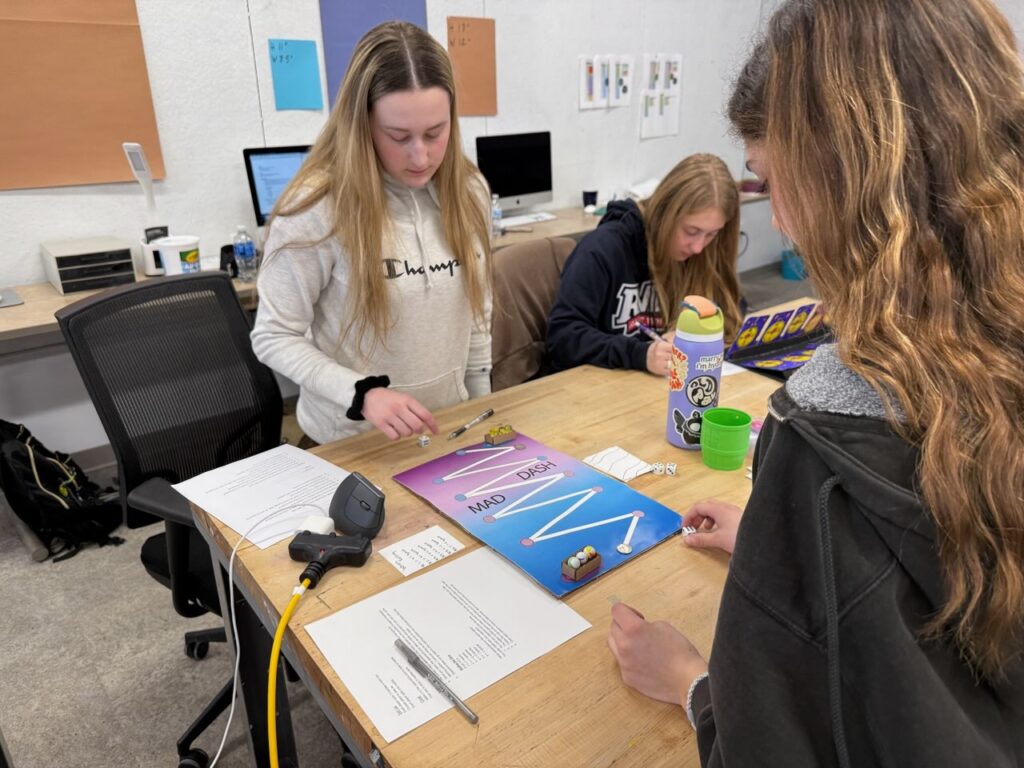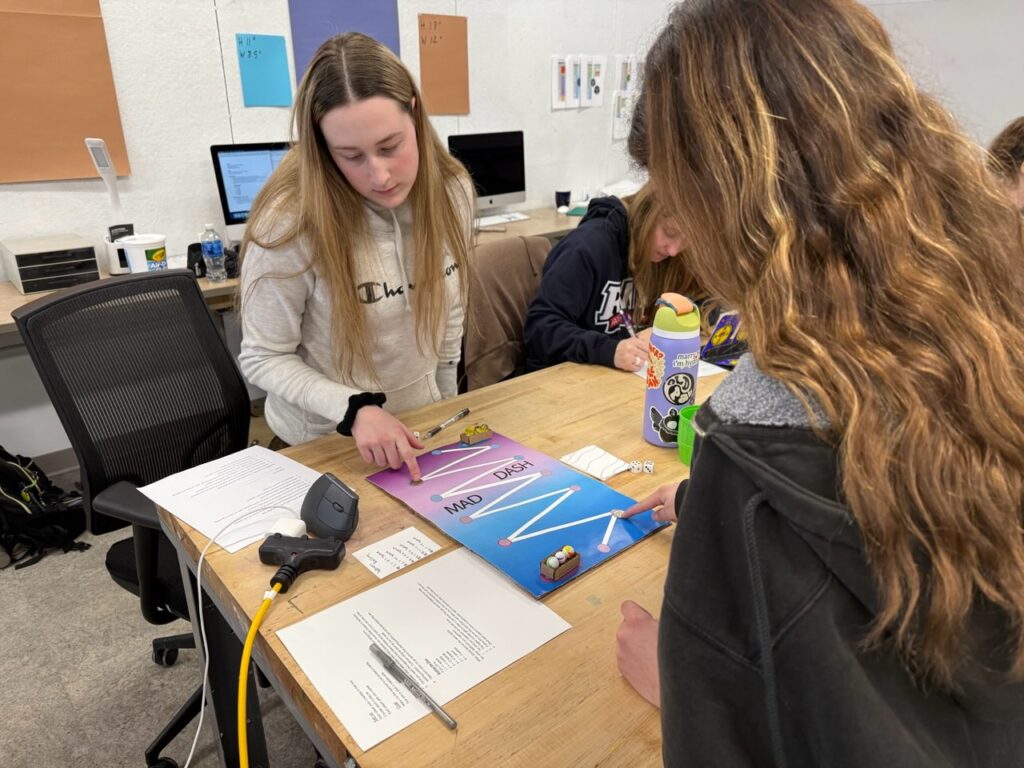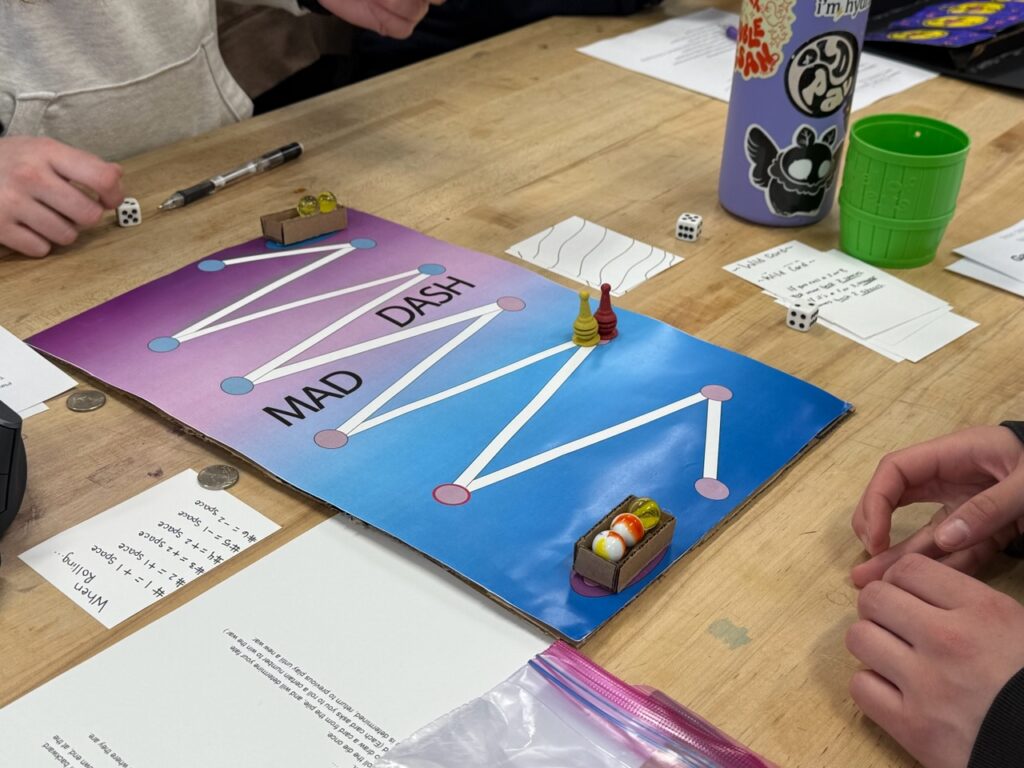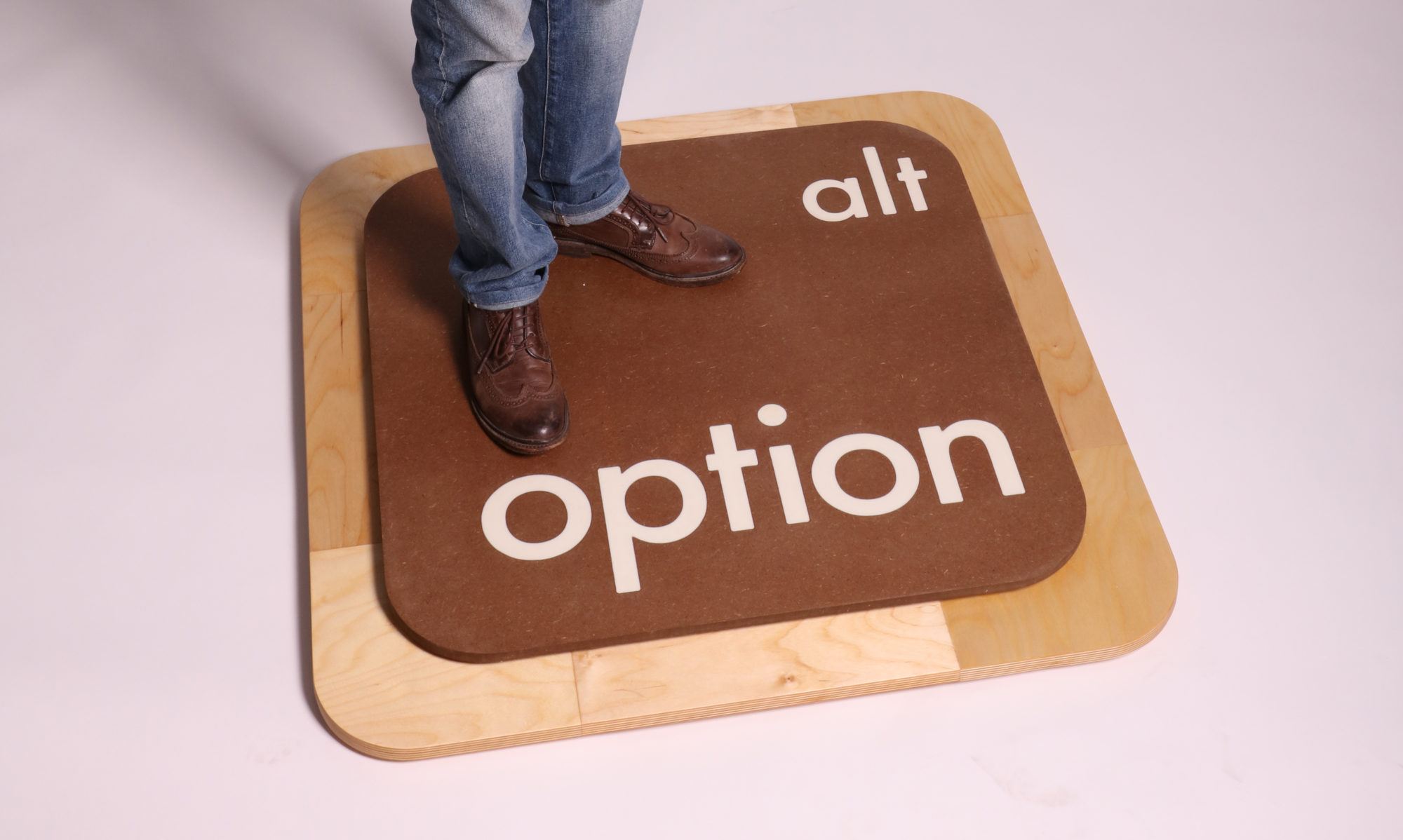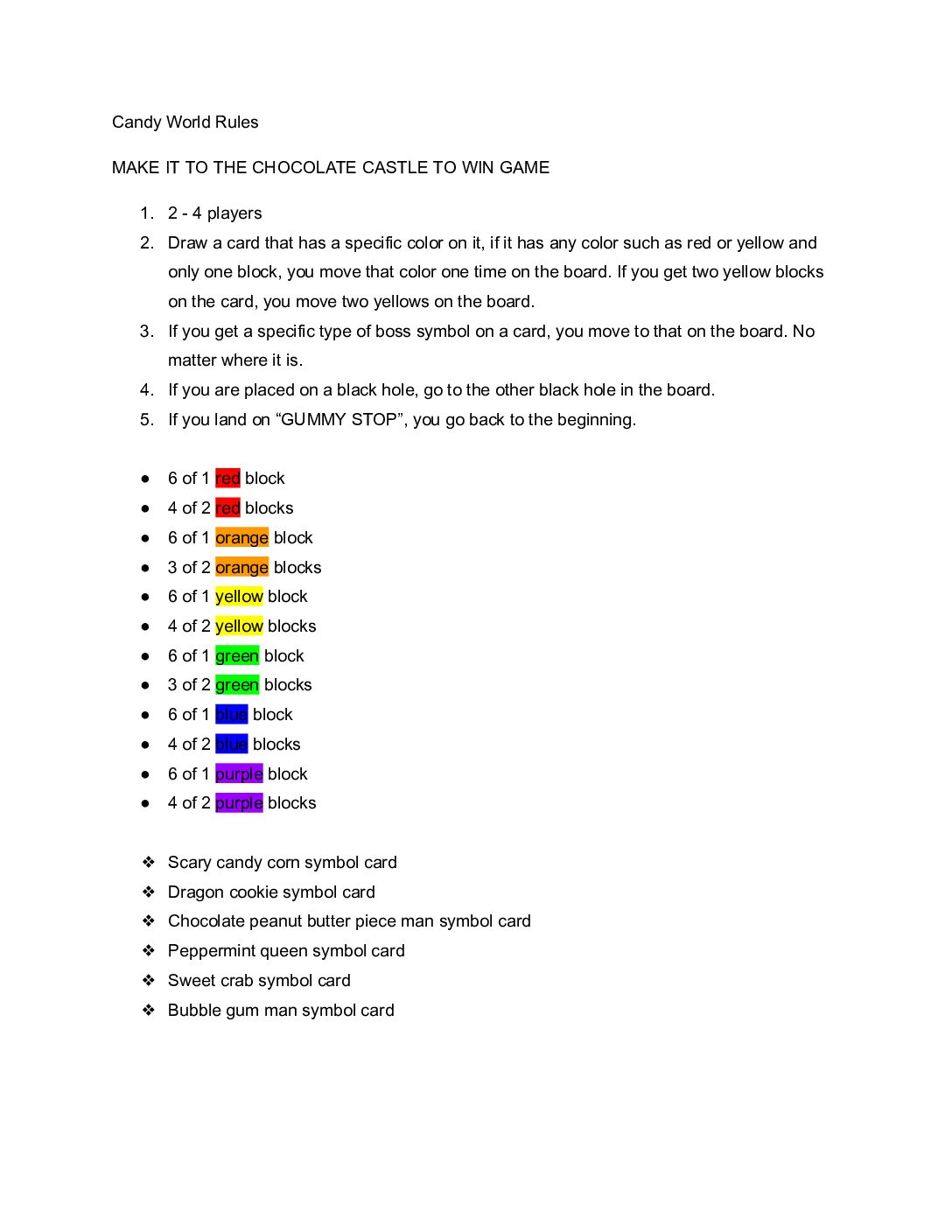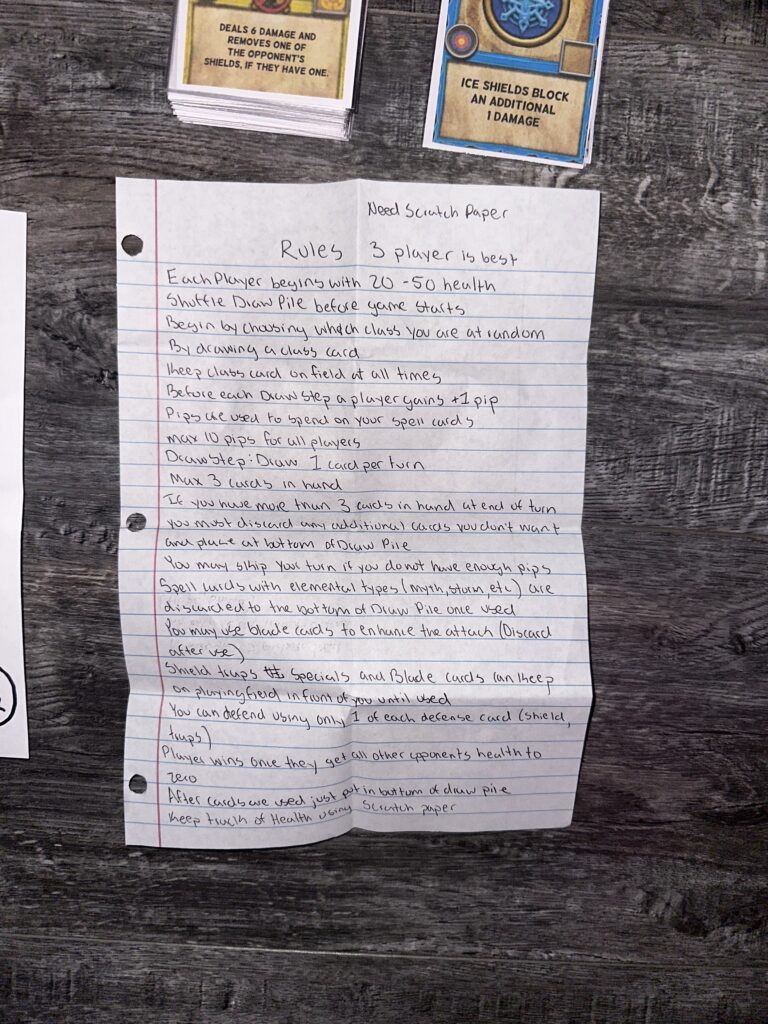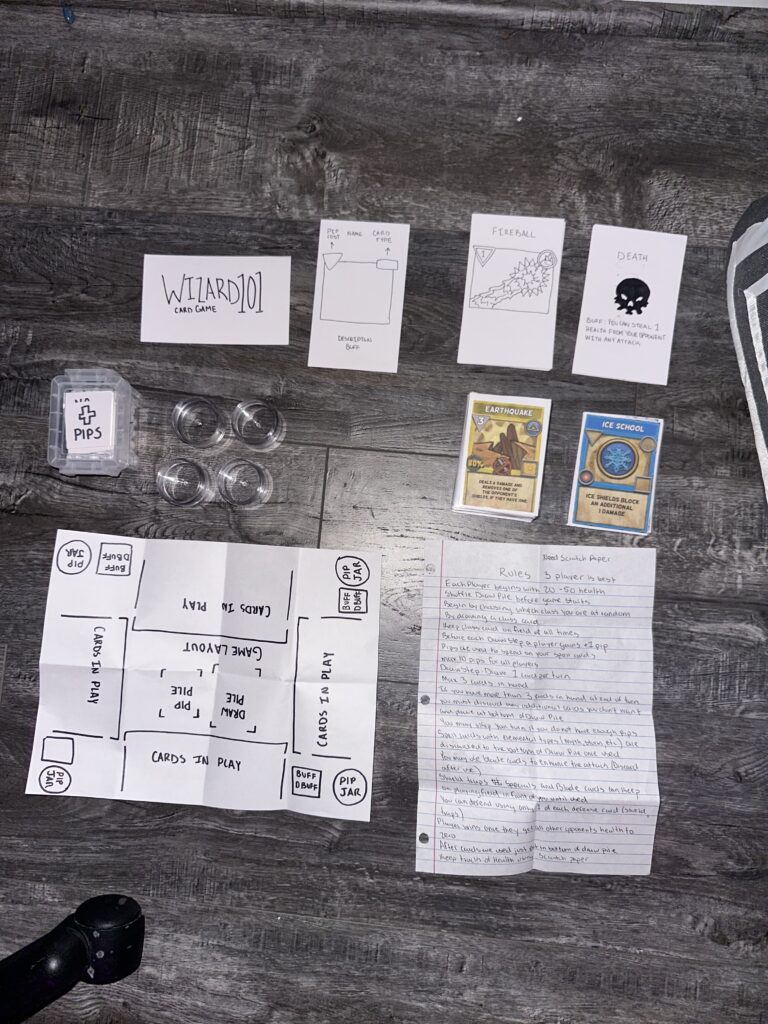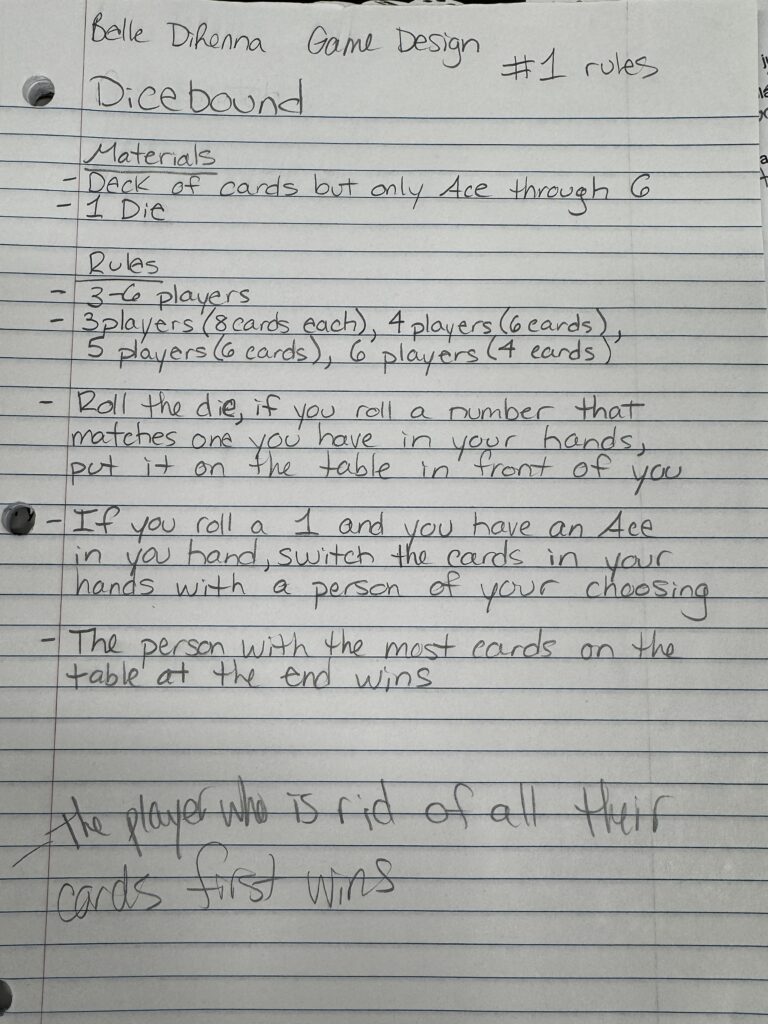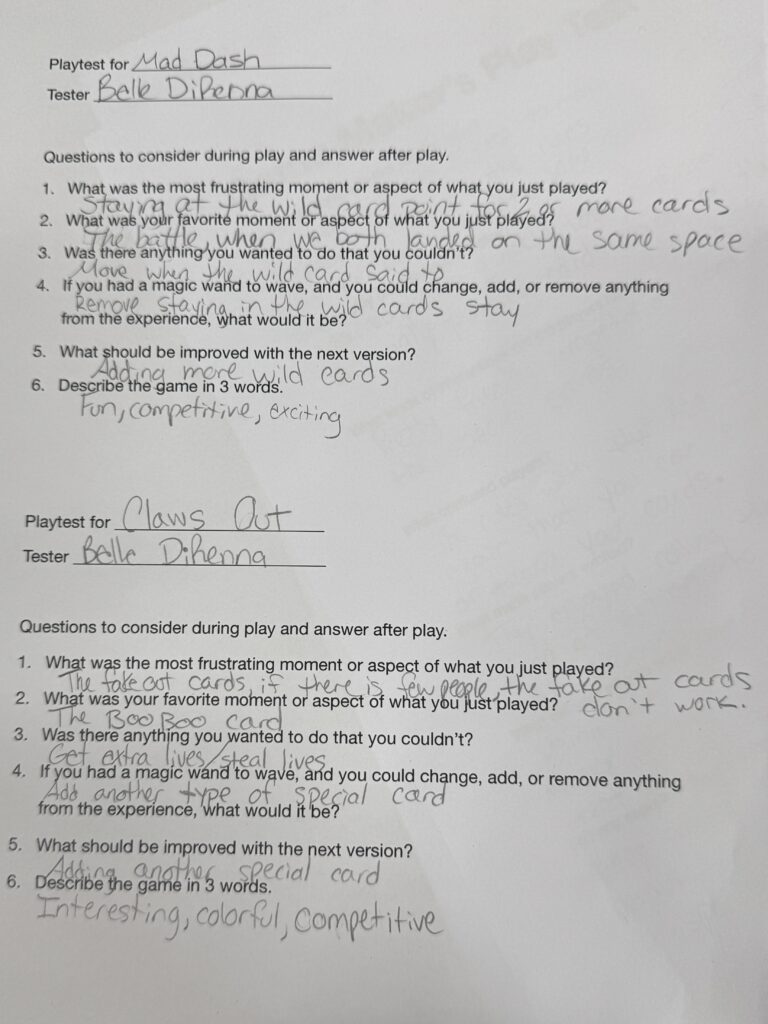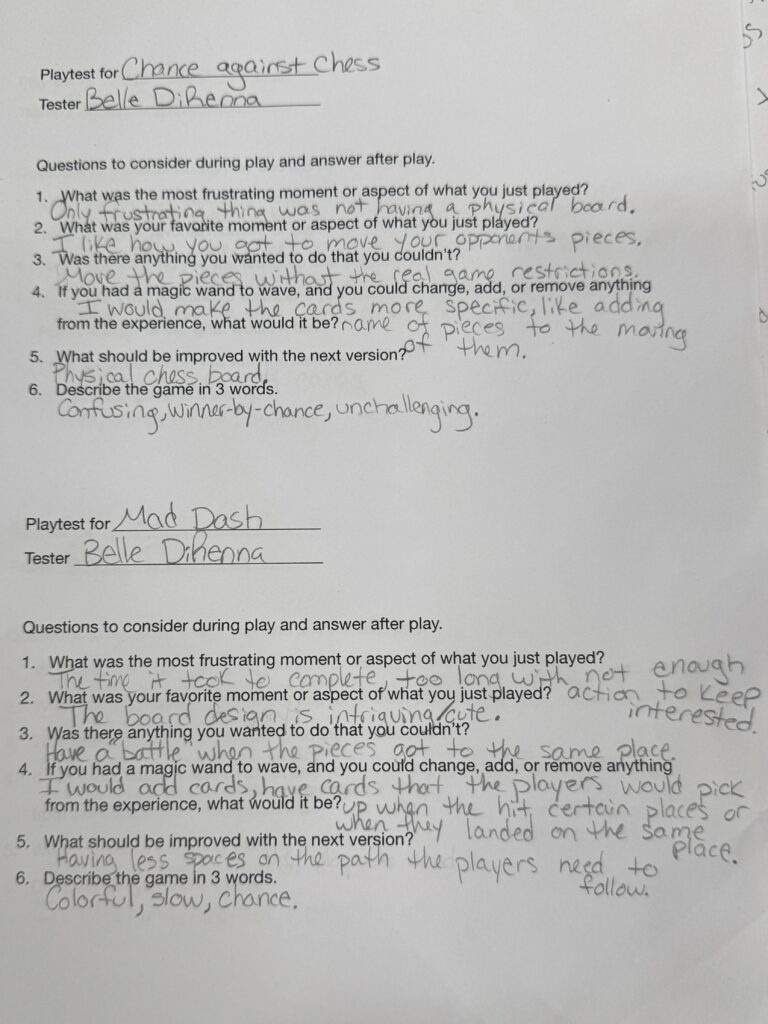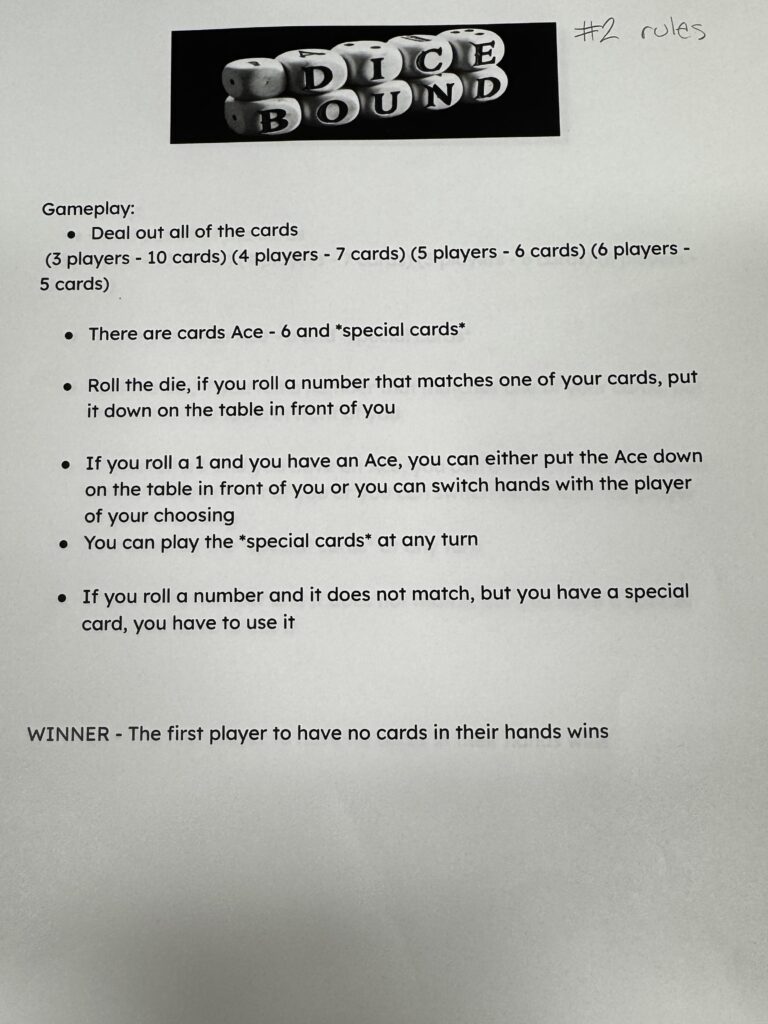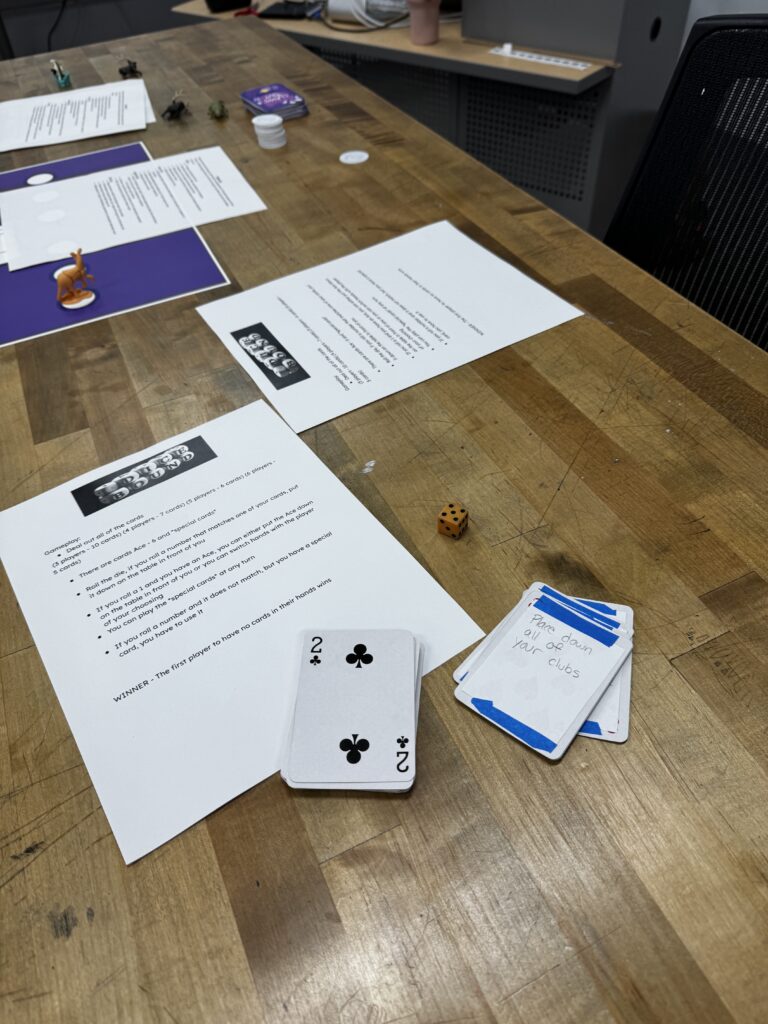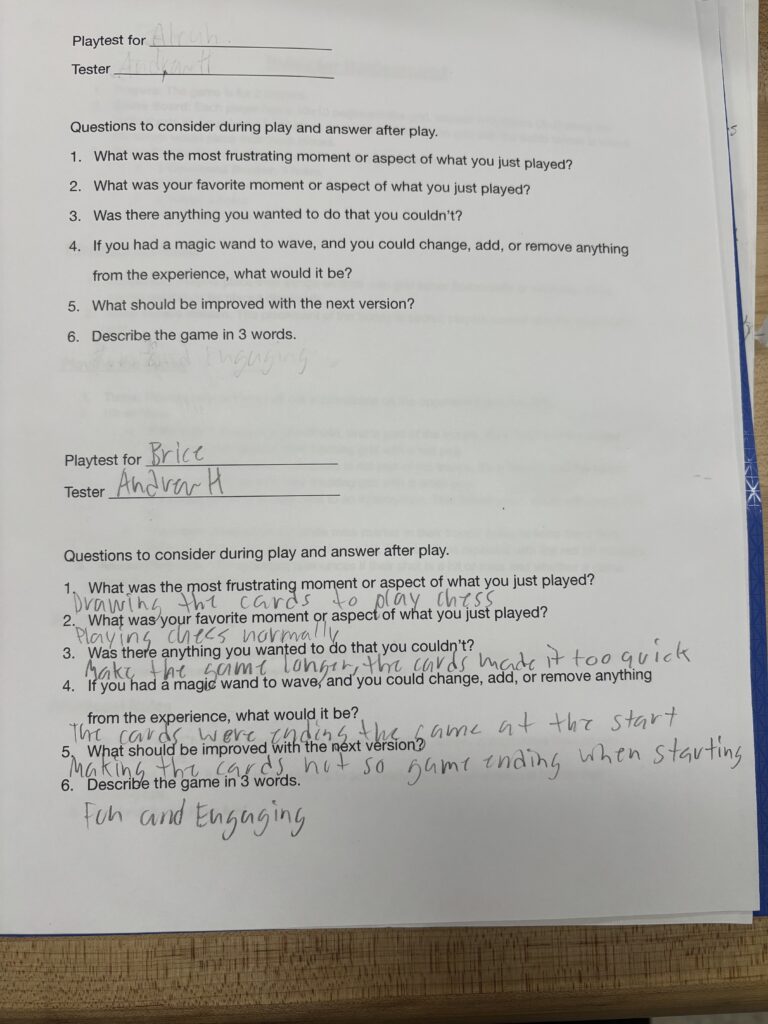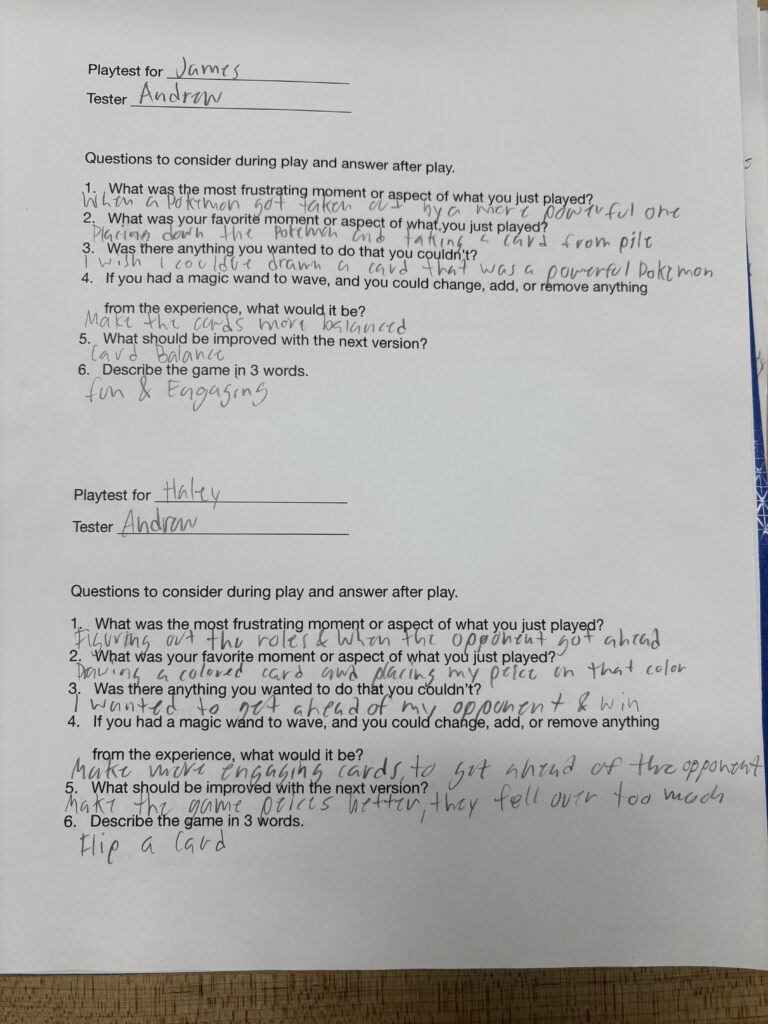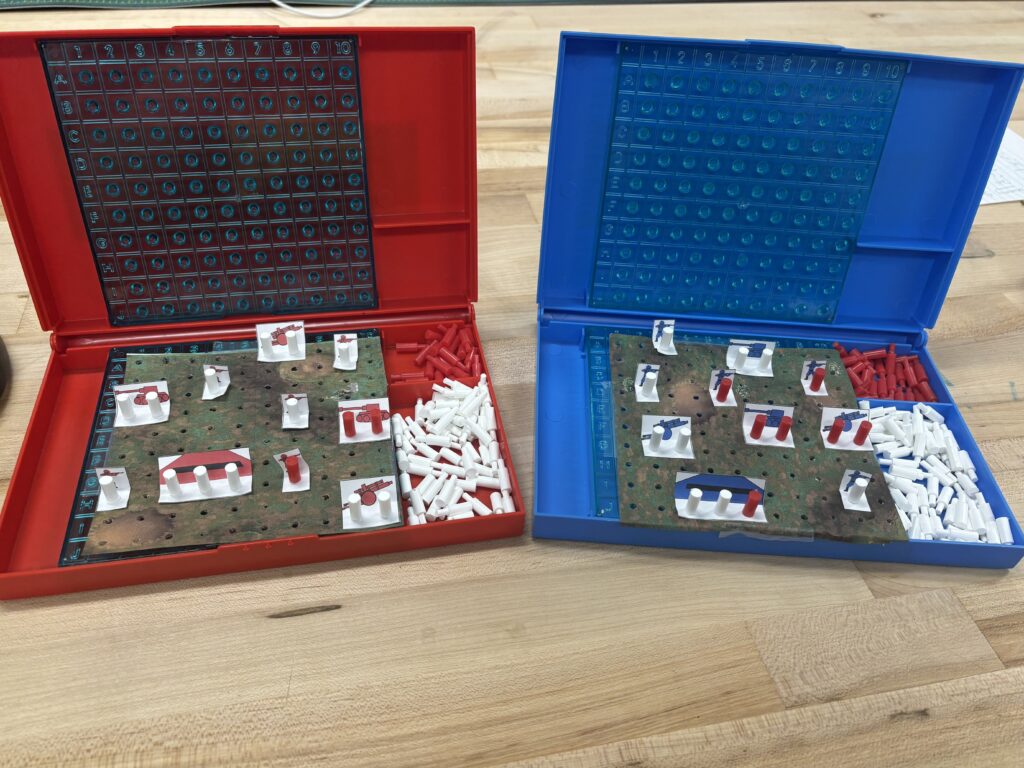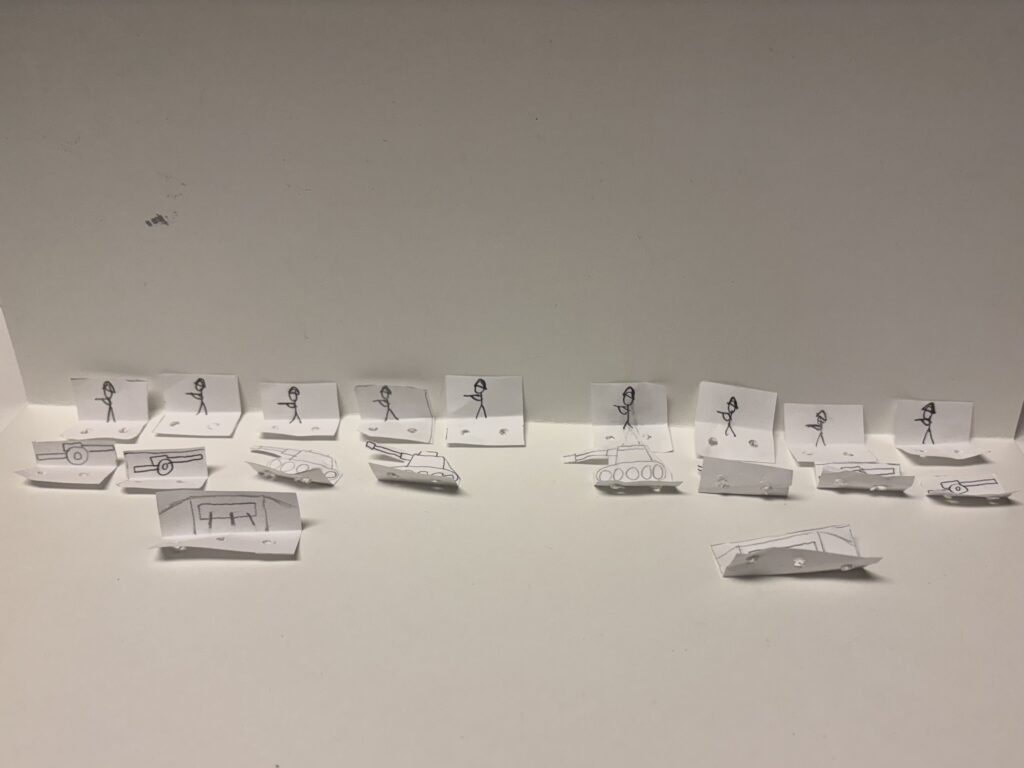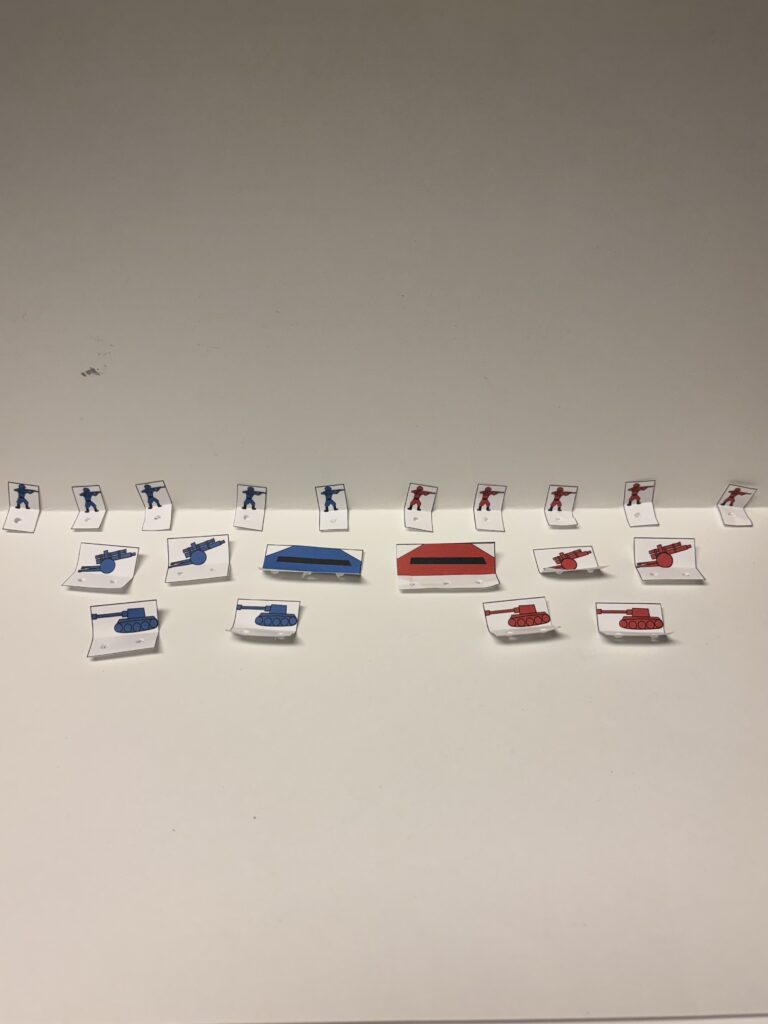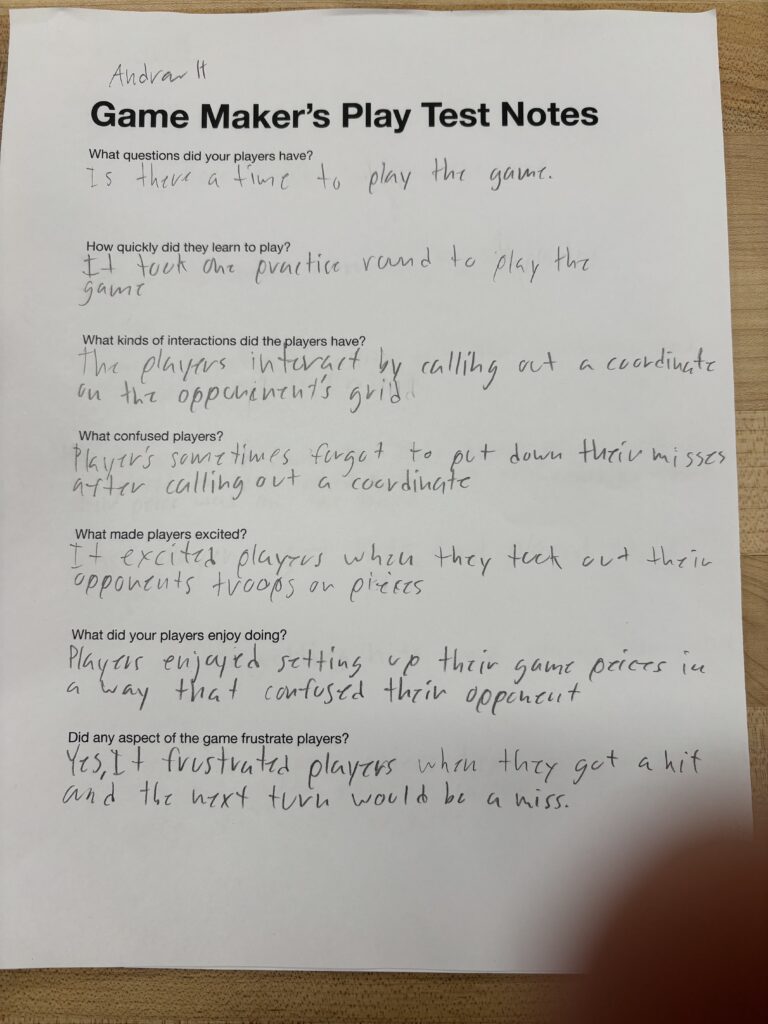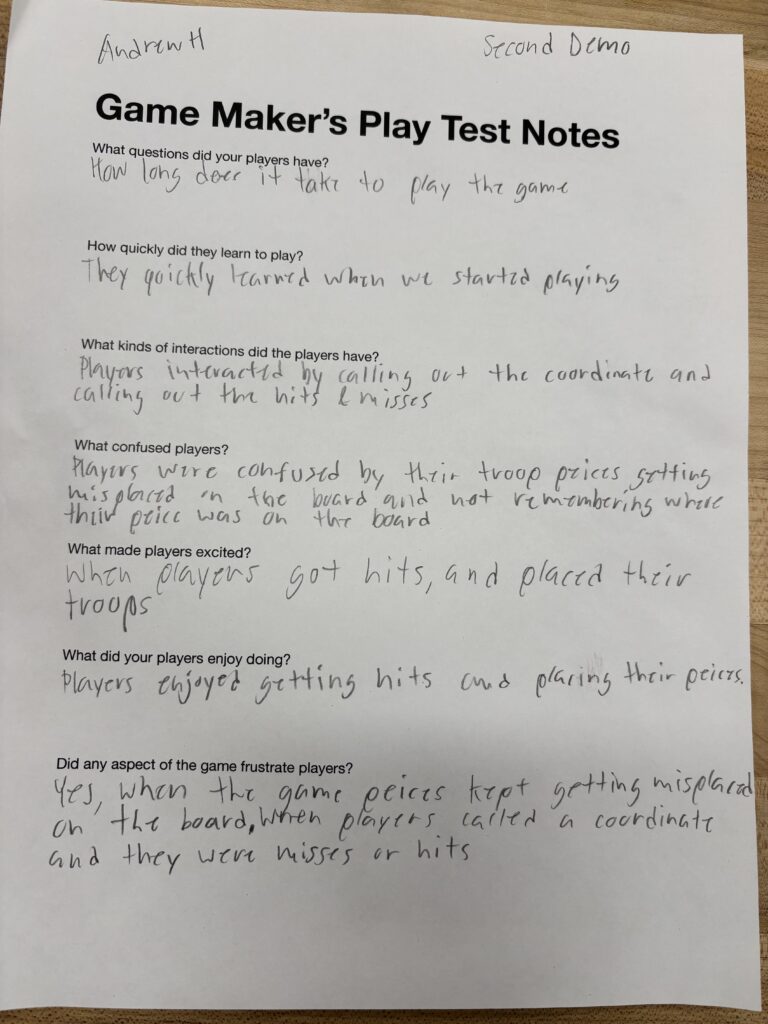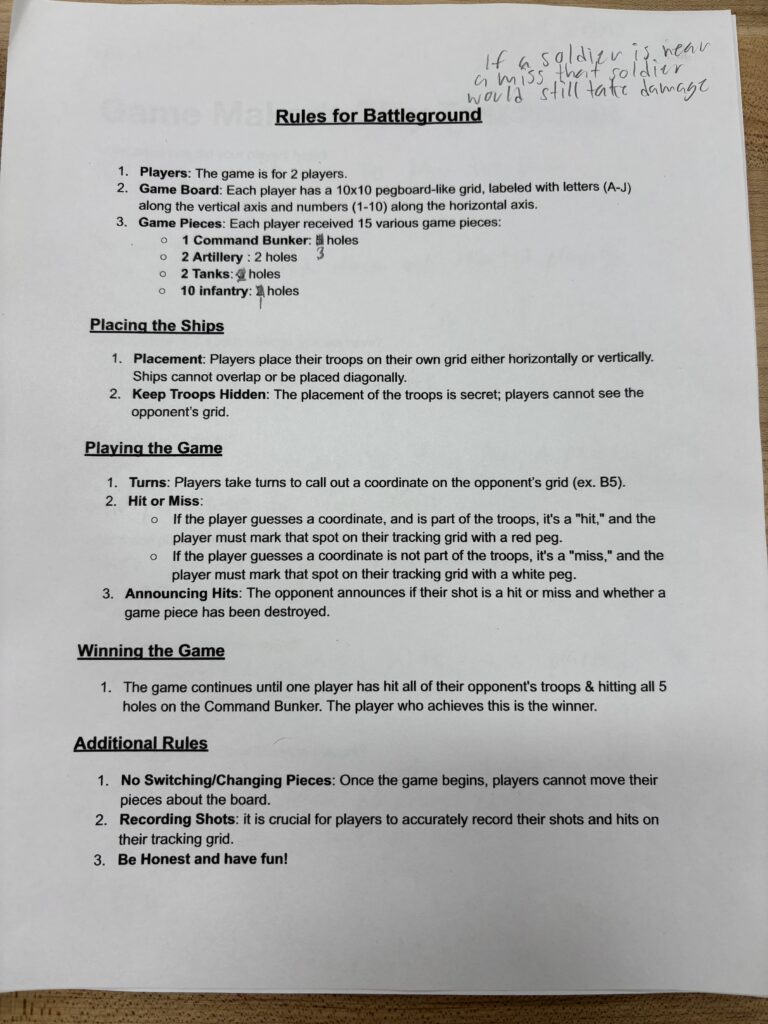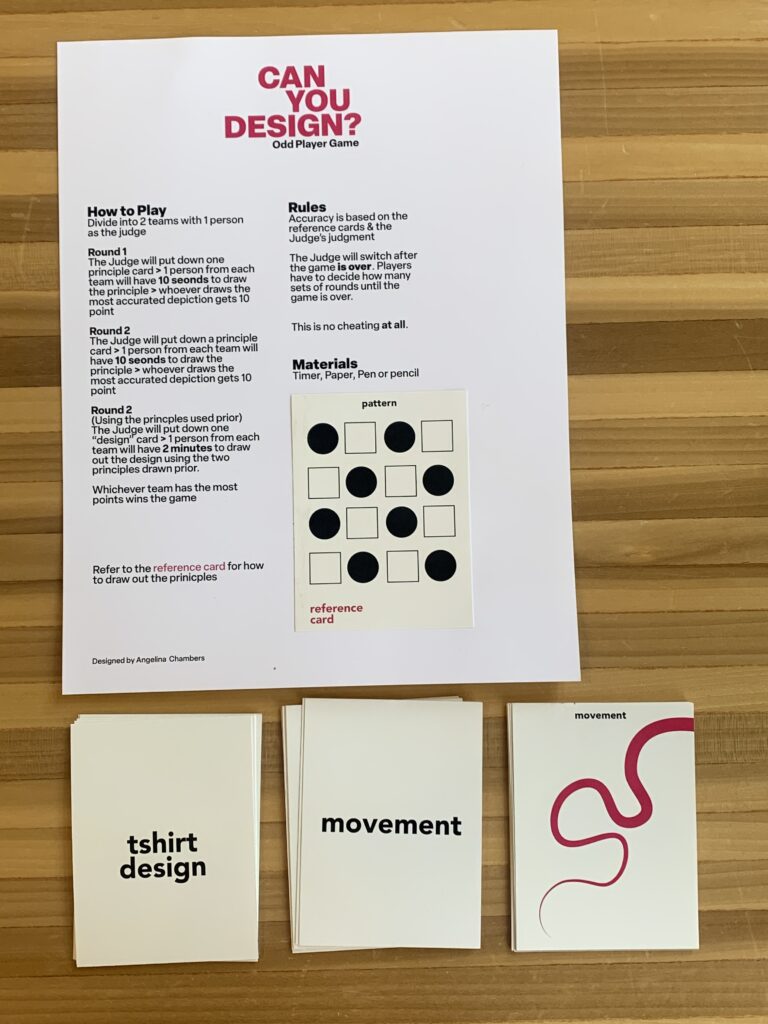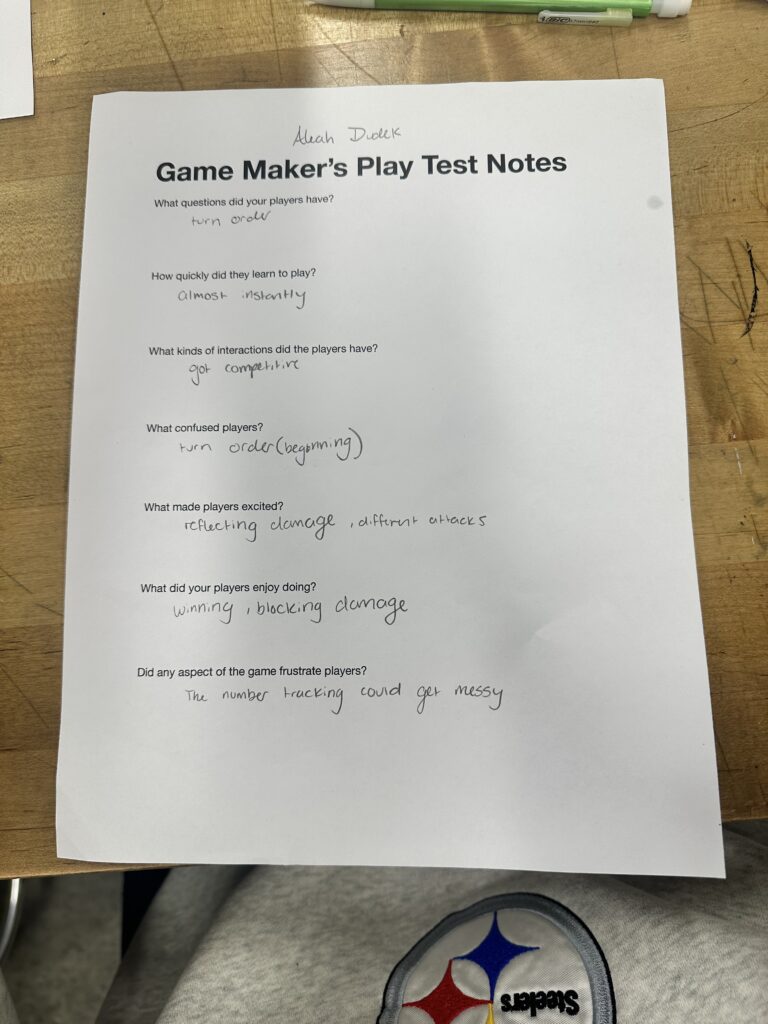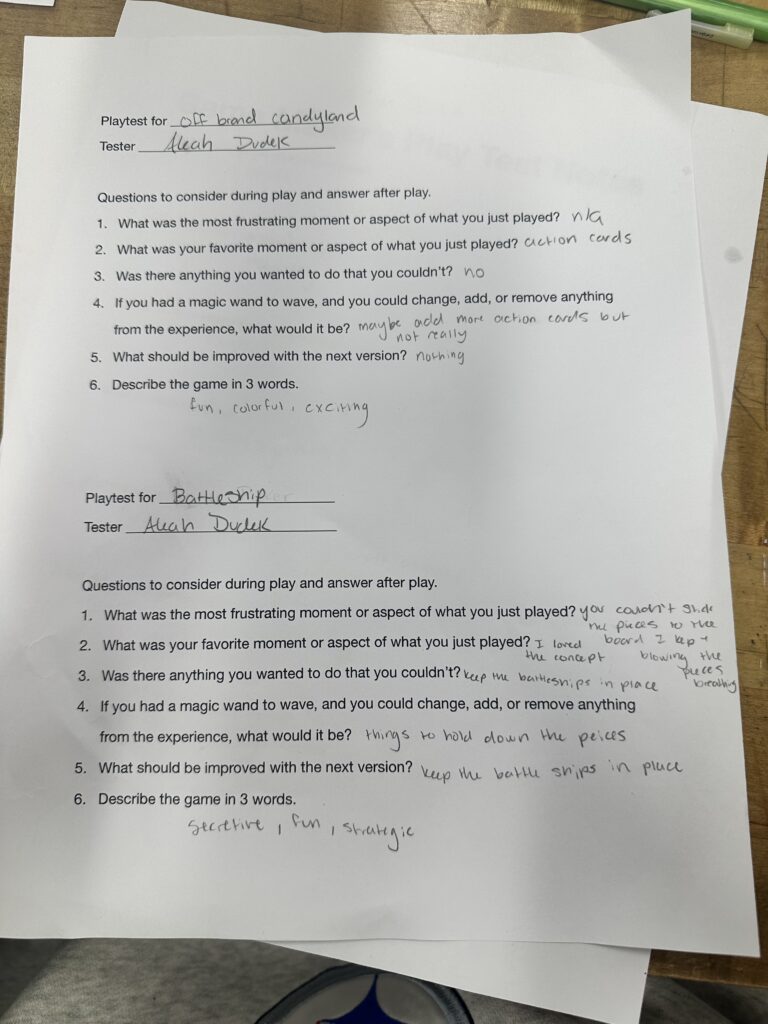Candy World game
First Attempt: For my game, I did not have it the first week we were doing games. So, I had a family member try it at home. They liked the game overall, but they wish I had more characters. Originally, I had two characters. The game I was going off of was Candy Land. Similar but had less rules to it. He also suggested I add more rules to the game. Unfortunately, I don’t have any pictures from the first try of my game.
Second Attempt: I was able to bring my game to class the second week we were trying them out. seems like a lot of people liked it. I noticed some people got a little confused over the rules in this one. But some requested to me that maybe in another change for the game, I added more rules to the game to make it little more engaging.
At home family answers: Questions to consider during play and answer after play.
- What was the most frustrating moment or aspect of what you just played? Trying to understand where to go.
- What was your favorite moment or aspect of what you just played? Trying to get a good card.
- Was there anything you wanted to do that you couldn’t? Try to get a three color card.
- If you had a magic wand to wave, and you could change, add, or remove anything from the experience, what would it be? Making more cards, add three colors or go back two.
- What should be improved with the next version? Make more cards and more rules.
- Describe the game in 3 words. Fun, exciting, interesting.
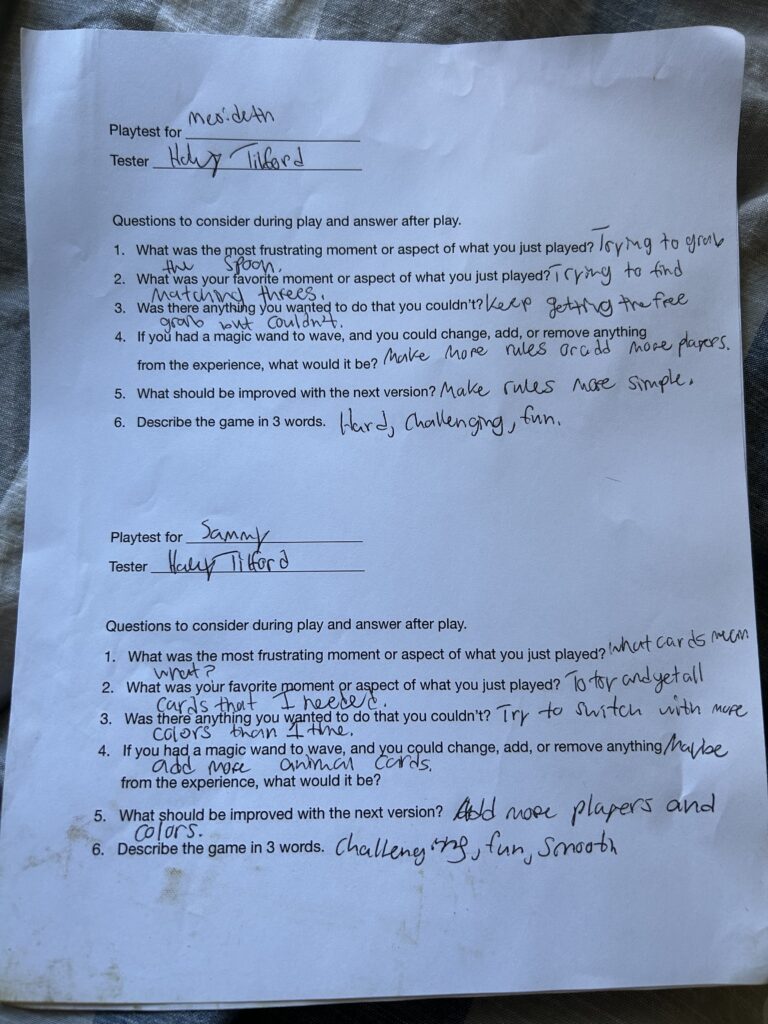
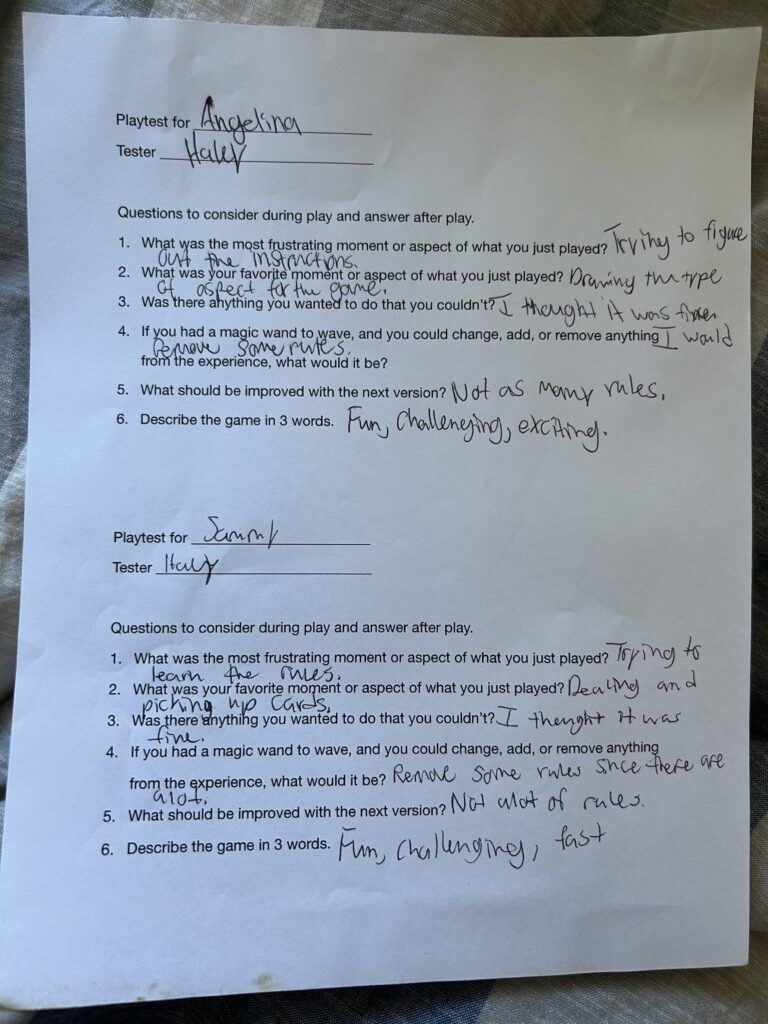
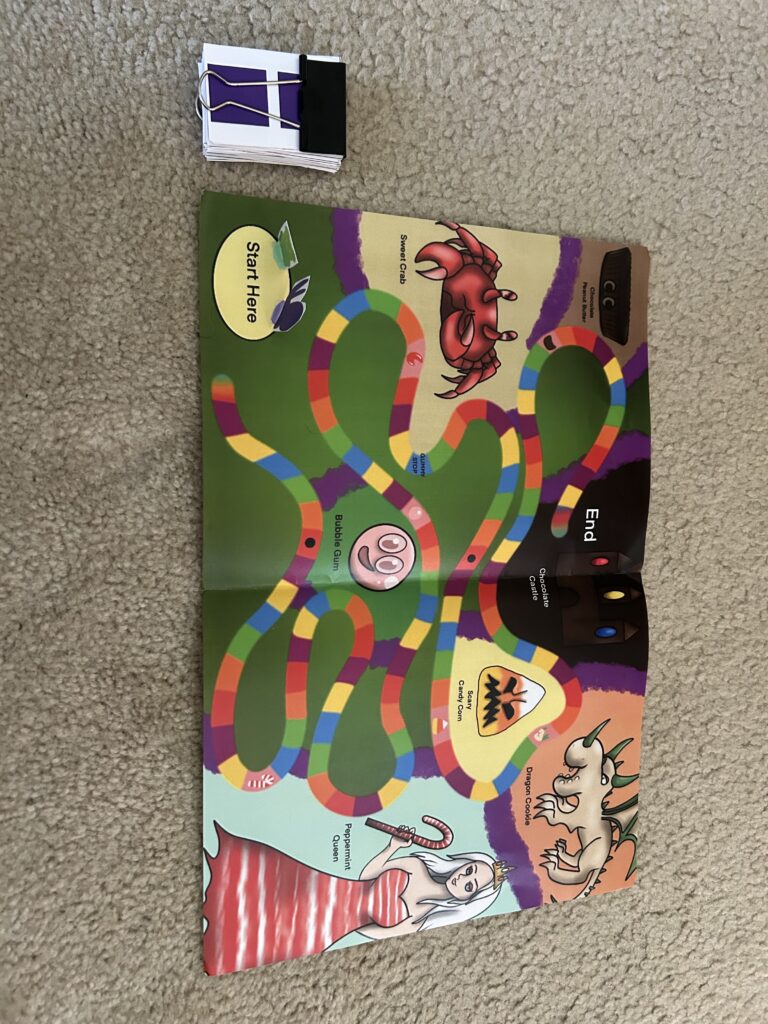
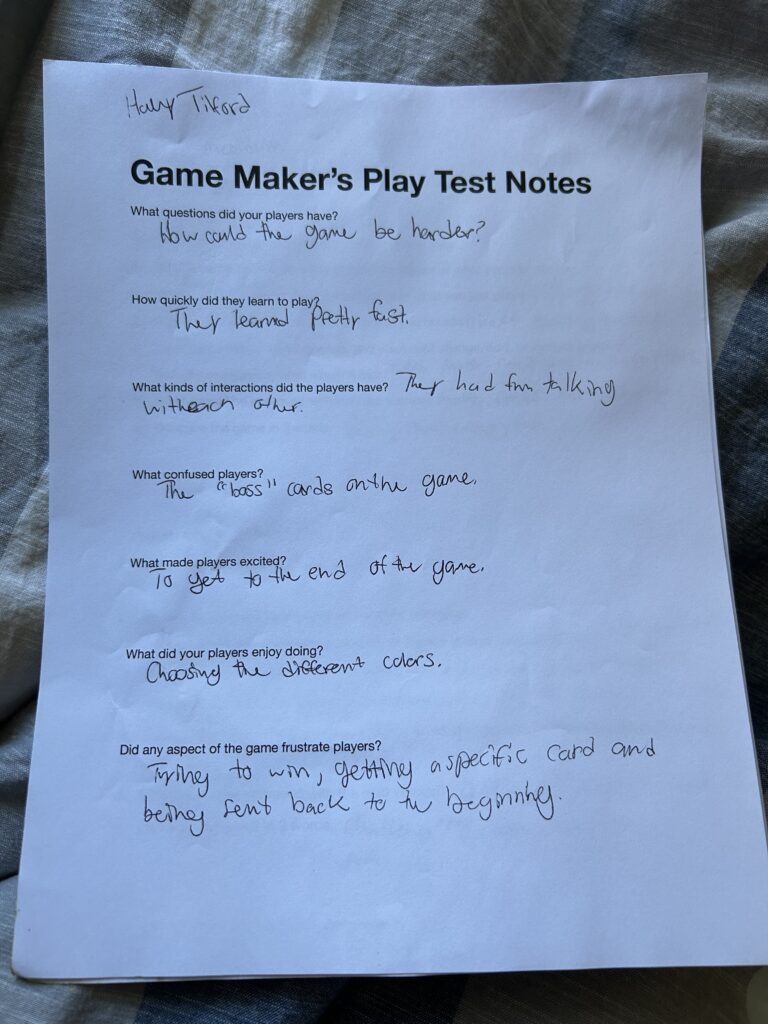
Wizard 101 Card Game Norina
Monster guess who?
Game progress and rules, worked in project with Sarah Juristy
https://rmu.andrewyames.com/wp-content/uploads/2025/03/Daria-Komarova-Progress-of-game.docx
Dicebound Game Design
Battleground game
Sammy Homer’s Game Rules
Harding – Game Rules
Pokemon 4D Studio Version
Use 40 cards in a deck.
Flip a coin to see who goes first.
Whoever goes first cannot attack during their first turn.
Draw 4 cards and place them facedown in front of your deck. These would be considered your prize cards. When you knock out your opponent’s Pokémon, draw a prize card. When you draw all 4 before your opponent does, you win. You also win if your opponent has no remaining pokemon on the field.
The game continues even if a player’s deck runs out of cards.
Both players draw 7 cards at the beginning of the game. If you don’t have at least 1 pokemon in your hand to play on the playing field, shuffle your hand into your deck and draw 7 new cards. Repeat until you are able to play at least 1 pokemon.
*Optional (You also have the option to reshuffle if you only have 1 pokemon in your hand and do not wish to play it down.)
Each player draws one card at the beginning of their turn.
Each player can only have one attacking Pokémon and a maximum of five on the bench.
Each player can play as many Pokémon on their bench up to the 5-bench maximum.
For this game, disregard the energy costs and effects such as burned, poisoned, paralyzed and asleep.
Each player can only attack once per turn and if the damage counters total or exceeds the HP of the Pokémon, the Pokémon would be knocked out and placed in the discard pile.
Trainer cards can only be played during the player’s turn. And a player can play as many as they have in their hand. Once played, the trainer card is discarded.
Stadium cards are placed on the field separately and any player can replace them with another stadium card.
Pokémon powers can only be used once per game per Pokémon.
Evolution cards are placed on top of the pokemon they correspond with (the card will say “evolves from X”)
During attacking, choose the attack and if the attack does damage place the damage counters on the defending Pokémon and the other appropriate Pokémon if applicable. Once you attacked, your turn is over.
You can have an unlimited number of cards in your hand.
You are allowed to retreat your attacking pokemon and switch it with one of your benched pokemon, this is allowed only once during your turn. And this is done before your attack.

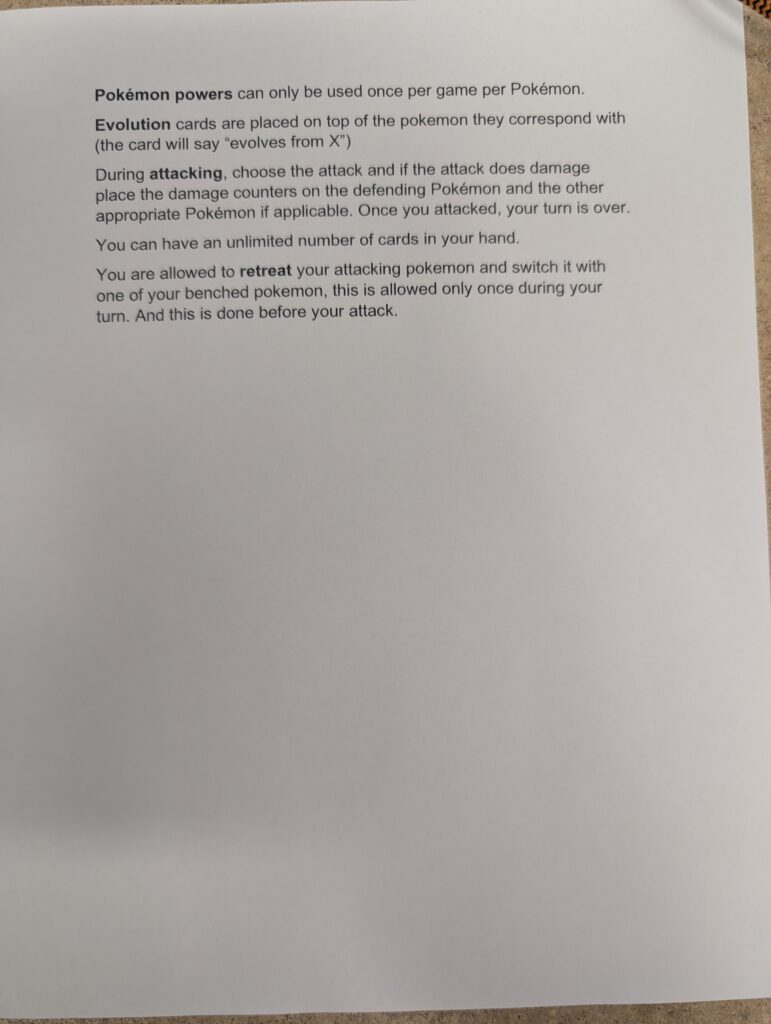
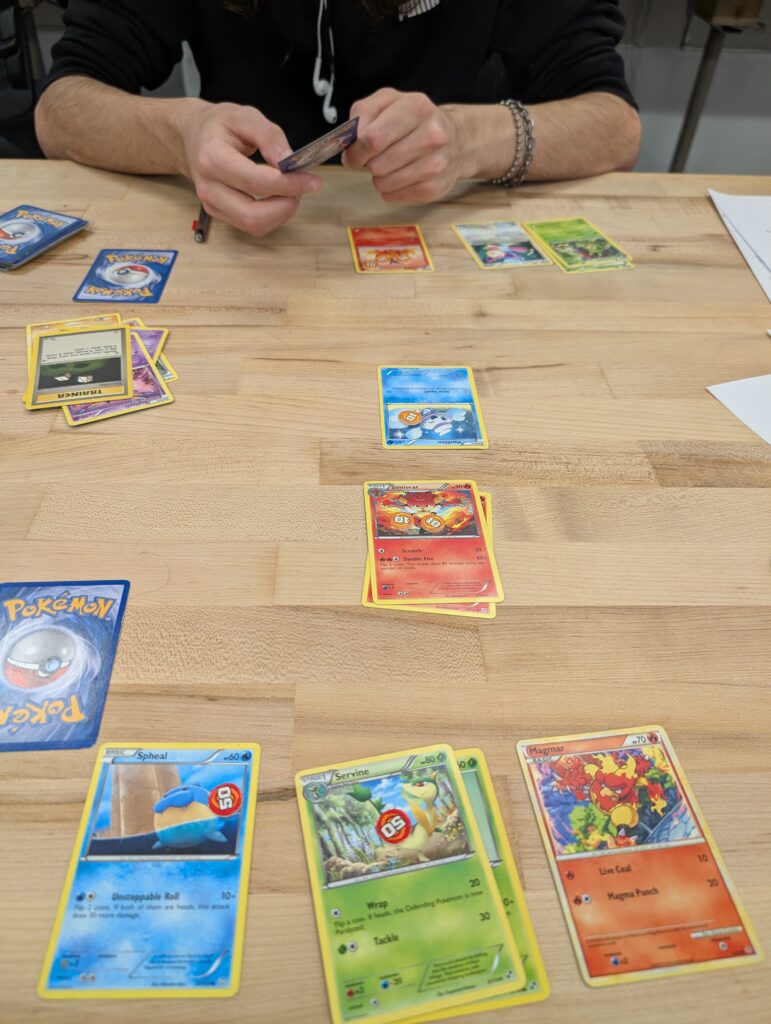
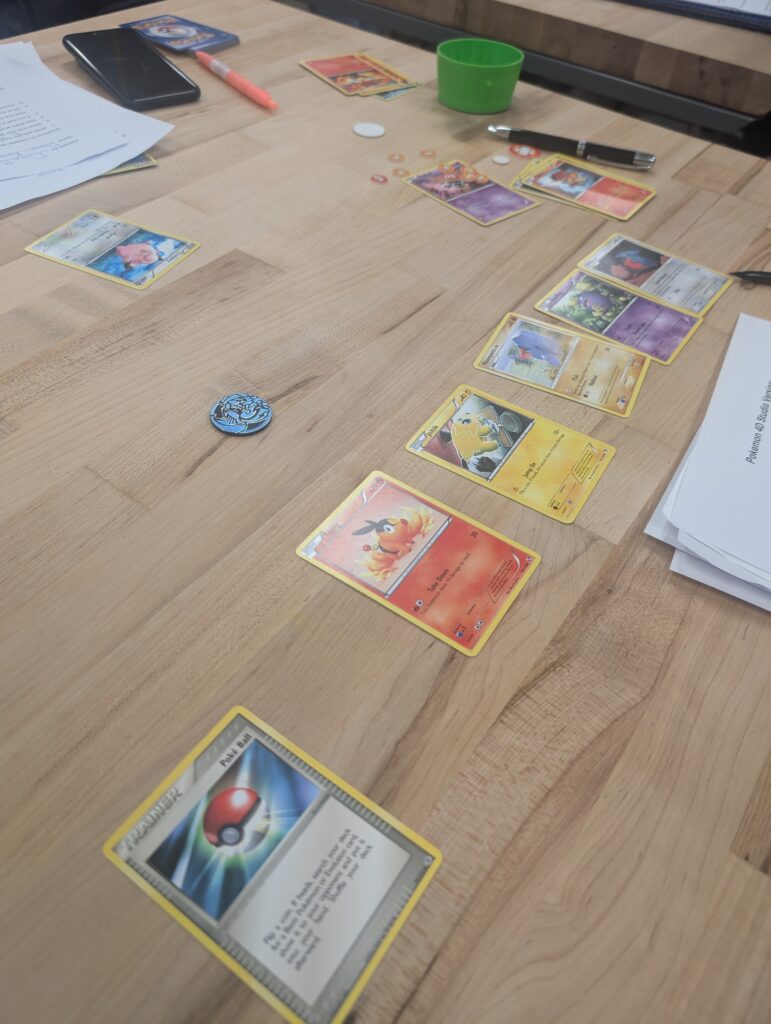
Play Test Notes
I feel that the experience the other student had with this version of the game seemed more technical than the other games within the classroom. The trainer cards had a wide range of impact and can change the experience of the gameplay very quickly. Some students picked up on the rules more quickly than others.
This version of the game seem to have had a positive engagement for the students that tested this game.
Final Game – Can You Design?
Game Maker Play Notes Part 2 Sammy Homer
First version:
This game is a card game that was originally called Animal Pickup which had player’s pick-up abilities and have a chance of getting animal cards. Once you get all of your colored animal cards then the player win.
I realized I needed way more ability cards with different uses, less animal cards, and a way to get different colored animals out of a player’s hand
Second version:
I change the name to Critter Picker and change the goal to have 2 sets of colored cards to win (instead of specific-colored cards). I’ve also added abilities to animal cards that only activate if the player has the specific color. Additionally, I made it so there’s an animal pile and an ability pile instead of it being intermingled.
I realized I need a better way of showing the animal pile vs the ability pile as well as adding or lessening some ability cards. I’ve also realized having 2 sets of colored cards may be a bit much especially for 2 players. Additionally, I need balance some card abilities and have clearer instructions (especially on the cards)
Game Review Mason T, Maria W, Aleah D
Created by Mason Tosadori, Aleah Dudek, and Maria Wack
- First Version
- What we originally made
- A 2 player game that consisted of 4 different classes to play, each character had a male and female model.
- Each character had 6 abilities, numbered 1-6. Moves 1-5 for each character dealt flat damage, and ability 6 was a special move specific to each character.
- Each character has a passive ability that would help them throughout the game.
- Players would each pick their character and then play rock-paper-scissors to see who goes. Whoever won would roll their die and attack their opponent. The opponent being attacked did not do anything for that turn.
- Once that attack is over, the players would play rock-paper-scissors again. The game would end when someone reached 0 health.
- What we learned
- We learned that some of the passive abilities were too strong, while others were too weak.
- Some characters repeatedly healed and became too strong.
- The various characters blended together, and we wanted to create differentiation.
- Players had questions about some of the wording.
- What we originally made
- Second Version
- What we changed
- We added alternate names for the characters and created specific cards for them (ex. Rogue and Assassin). The characters were the same but given different names, which gave the illusion that there were more characters to choose from.
- We added a defense system. Players could now roll a dice while being attacked to reduce damage and still be active during the game.
- We changed some of the passives to make them more balanced, as well as added cool new abilities for the defense system.
- We made it so there would be max health so a character couldn’t keep healing and accumulating health.
- We reworded some rules and made them more specific so that the rules were more defined.
- What we changed
- What we learned
- We realized that the knight’s shield needed to have a maximum.
- We also learned that we should lower some of the Rogue’s defensive abilities. This would fit the character more and balance the game.
- With the defensive system, the games would take a little longer, but this ended up being a good thing. It gave the opportunity to create epic moments of dodging and reflecting damage to have a comeback.
- Third Version
- What we changed
- We reprinted the player cards to be smaller.
- We increased the attack DMG for the Knight and Paladin and adjusted their passive attack because their shield was initially too powerful.
- Shield is now separate from HP, and a max shield is set at 10.
- We lowered the Assassin/Rogue characters’ defensive abilities.
- We also wanted to add a token to use as a reminder for some of the abilities, mostly the Rogue’s abilities. The abilities would occur later in the game and not during the turn that it was rolled. This caused players to forget to use it.
- What we changed
Claws Out Game : By Mikayla Bayer & Meredith Berkheiser
First Attempt : In our first attempt of our game, we wanted to replicate the game spoons, but add action cards to the game to make it more competitive and fun. What we did, was grabbed a deck of cards and used sticky notes to replicate the action card ideas that we had. We took the feedback from our testers of getting rid of the life cards to make the game more challenging and added wild cards to make it more likely for players to get a match. It seemed like everyone was having a good time while playing the game and we listened to their frustrations and focused on eliminating them.
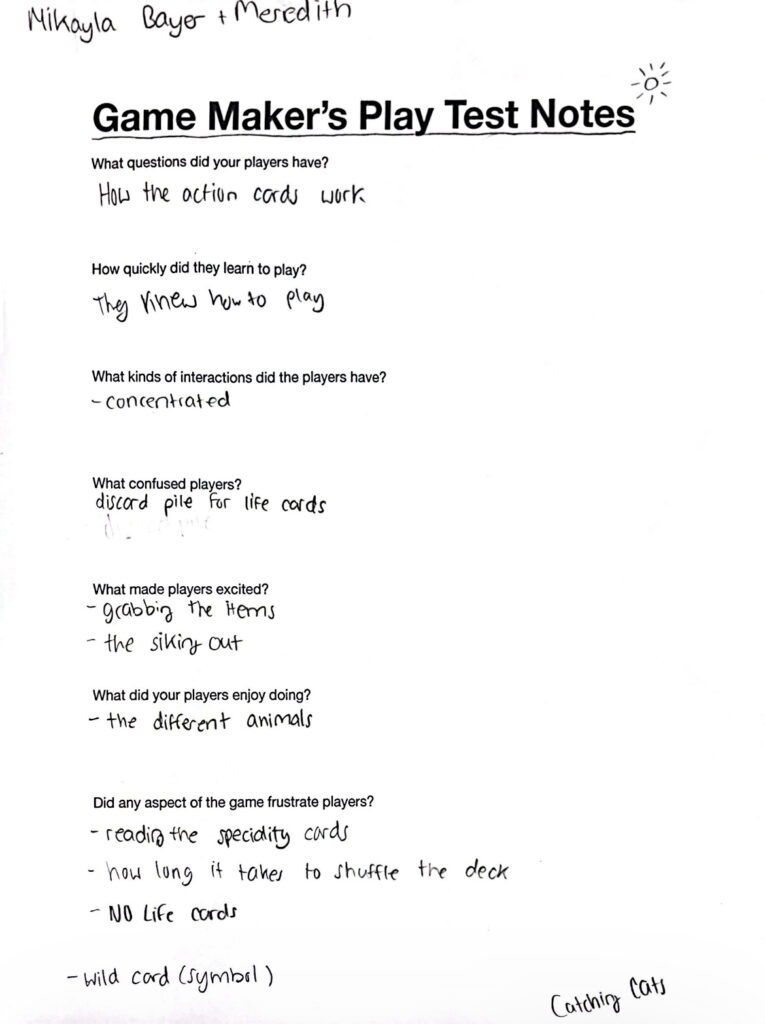
Second Attempt: In our second attempt, we decided to theme the game and go with a cat theme. With each card, we had cat illustrations to make it look aesthetically cute and playful. The action cards, we themed them to match the cat concept to match that idea of a playful feel. We made the cards the same amount as a deck of cards, but without a king, queen, or jack and replaced them with action cards. Once we had the cards made, we made sure to make our directions seem clear and had the players figure it out themselves. We also made a board to keep everything in place and to make sure the players knew where to put their discarded cards and knew where the figurines should go. We had a successful second attempt with a lot of popularity toward our game and some very competitive spirits. We got a lot of compliments, however our biggest critique was to get people to add lives back.
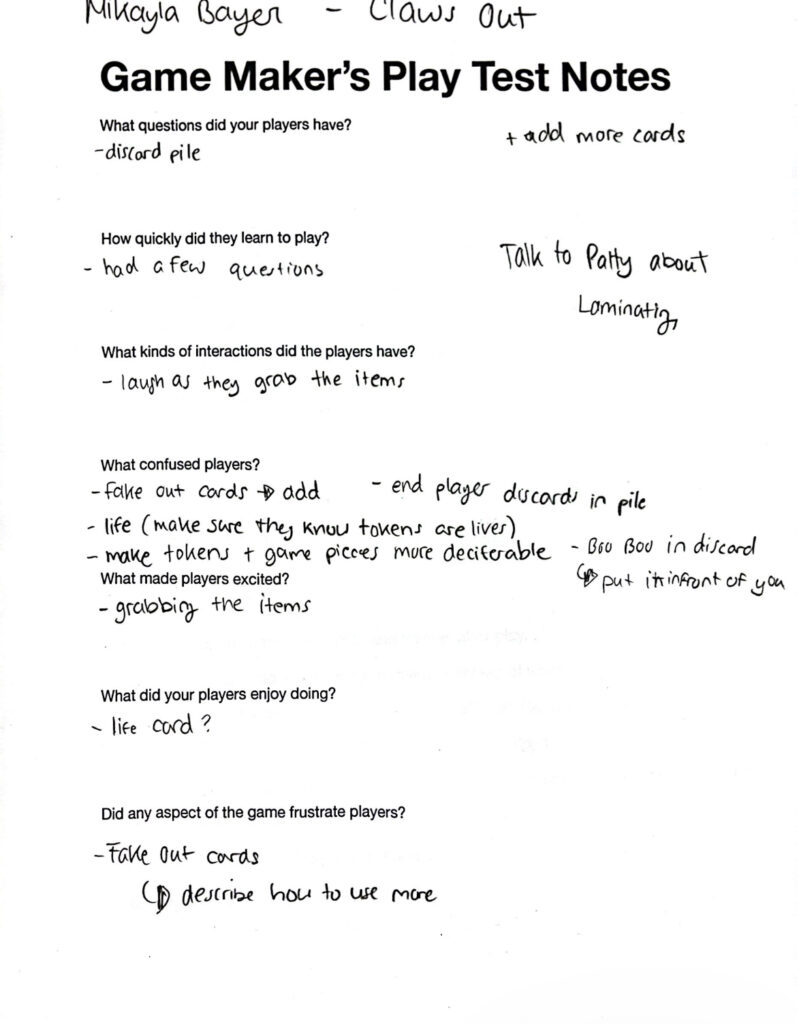
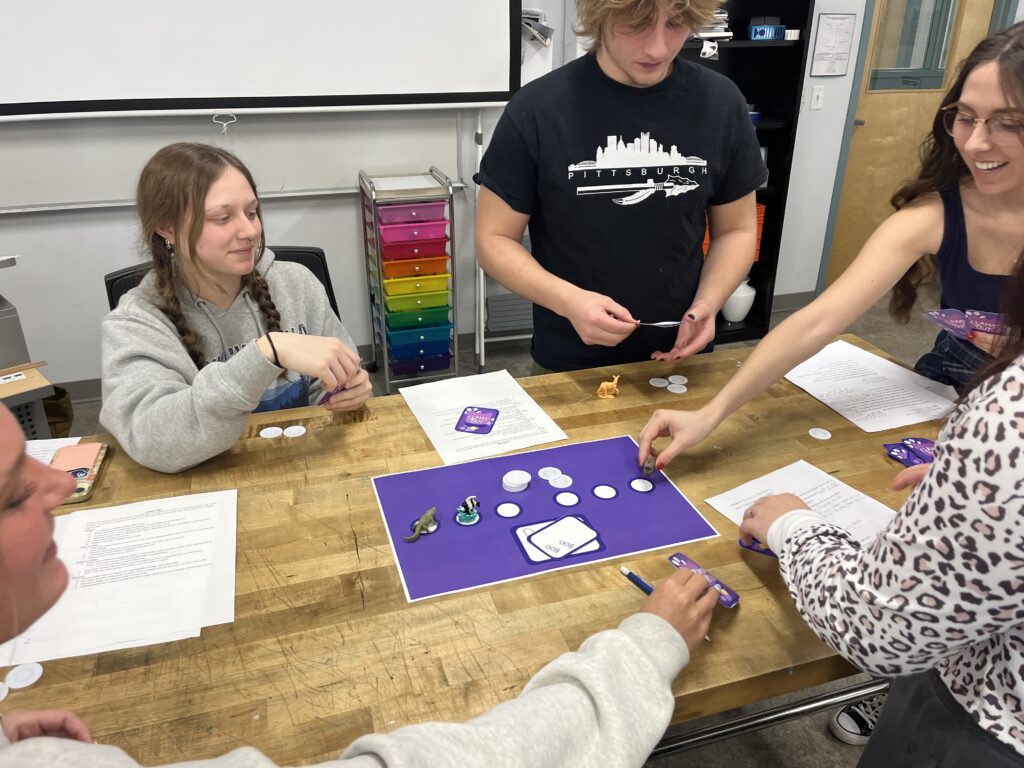
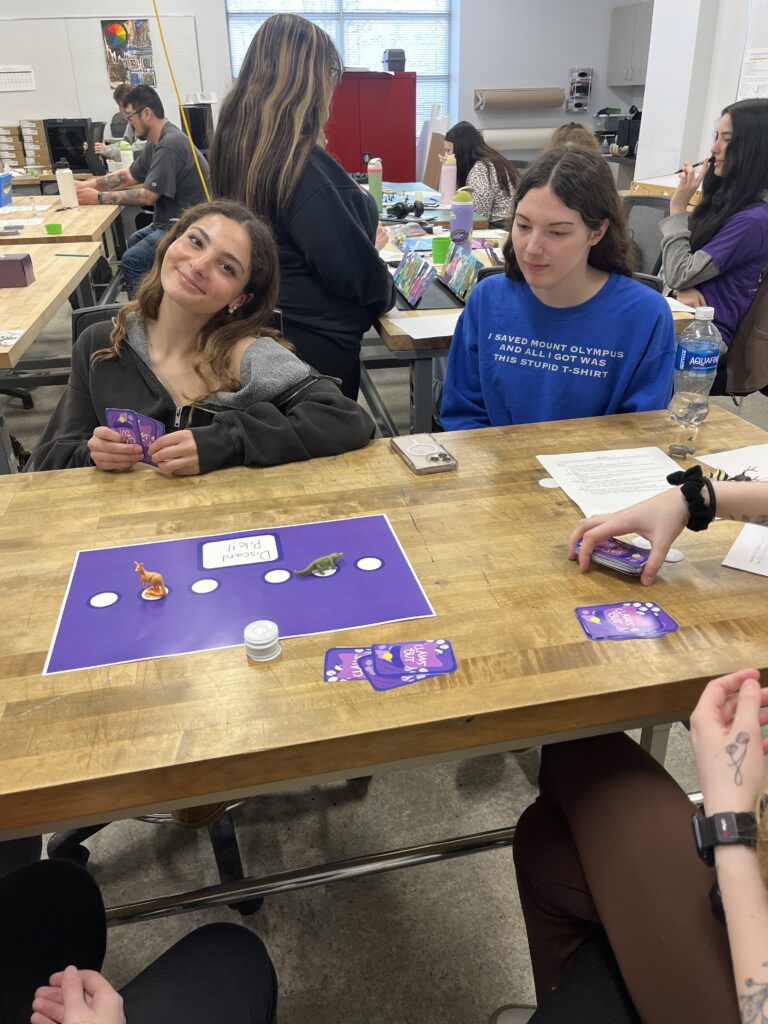
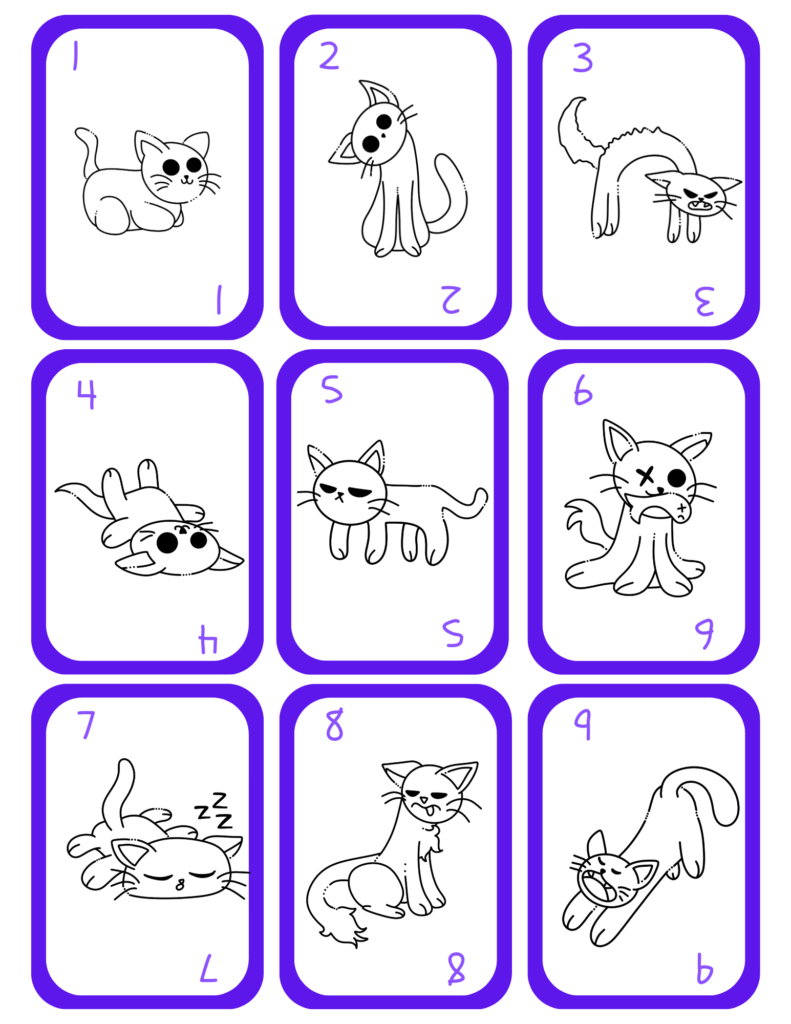

Third Attempt: Our next steps would be to make a sturdy game board with more designs on it as well as to color in the cats. We would also put more illustrations on our action cards and color those in as well. Another idea we had was to make the directions sheet look more fun and cute to make it all aesthetic to our cat theme game. As people were testing our game, we could find little errors here and there, so we would put some of those errors and make them more clear in our instructions. Overall, we are very happy with the turnout of our game and hope to explore and modify it in the future.
Game Play Testing part 2 notes Sammy Homer
Mad Dash
Kaley Rohanna and Madison Hurst
Mad Dash
By: Kaley Rohanna and Madison Hurst
Game Board Creation
What is Mad Dash:
A two player game requiring players to roll dice in order to progress their piece across the board. The goal is to get to the opponent’s end and steal all their marbles.
Materials:
4 marbles (2 for each player), 2 marble holders, 2 dice (1 for each player), 9 Wild Cards, 1 Dice Number Key, 2 player pieces, 11×17 cardboard, 11×17 cardstock board design,
Mad Dash Initial Testing:
- Coming into the first game board testing, we created a board design (11×17) on Adobe illustrator
- Kaley and I decided to go with each player having 3 marbles and a total of 10 spaces on the board.
- Mad Dash was intended for two people to play
- The initial instructions for this game was:
- One player must call out a number,#1-6 on the dice that was given, that both players are trying to obtain first
- First one to get a selected number moves their piece up one space, and gets to call out the next number.
- Once one player reaches the opponent’s side should take one of their marbles
- Both players will reset to their starting positions
- First person with all of the marbles wins
- Our findings was the game was never ending, and many players struggled to get at least one marble.
- The game always kept each player at neutral so, if one player stole a marble, a couple seconds later the opponent would equalize the playing field.
- Players were able to understand the game fairly quickly, but had a lot of questions come up regarding when they both landed on the same space.
- We let the players continue to play while still in the same space, and waited to see who rolled the selected number.
- The players were really excited when they attained a marble or got the selected number before the opponent.
- Some frustrating aspects of the game was it being slow/long, and going back to zero or starting space.
- Another question that was brought up was if the player that lost that round (didn’t get marble in time) had to also reset to starting positions as well.
- At the end of the board game testing, we had some key takeaways:
- Possibly having dice with red and green for each person, and making it a subtraction game.
- Or if you got a selected number on red dice, you had to go back a specific amount of spaces).
- One suggestion from the player was to change to one die and subtract both players’ roll and winner move up spaces. They said to make the board longer and add more checkpoints.
Mad Dash 2nd Testing:
In this test, we added wildcards to handle the instances where the players’ pieces reached the same space and gave each player only one die to roll.
Instructions for Testing 2:
Set up
Each player puts 3 marbles in their box
Choose piece to play as
Each player gets one marble
Goal
Make it to the opponent’s end to steal a marble
First one to steal 3 marbles wins
Instructions
- Each player constantly rolls their die, don’t worry about taking turns.
- The number rolled determines how many spaces you move either forward or backward.
- Once you reach the opponent’s end, take a marble and go back to your own end, at the starting position. Continue rolling as soon as you’re ready.
- Opponent does not go back to their starting position but continues where they are.
Rolling the Dice
If you roll a…
1 = +1 space
2 = +1 space
3 = +2 spaces
4 = +2 spaces
5 = -1 space
6 = -2 spaces
When pieces land on the same space…
You enter WAR with your opponent.
- You and your opponent roll the die once.
- The higher number gets to draw a card from the pile, and will determine your fate.
- Follow the rule on the card (Each card asks you to roll a certain number to win the war.)
- Once each player’s move is determined, return to previous play until a new war.
- Many people enjoyed the addition of the wild cards.
- Landing on the same space and stealing a marble excited the players.
- The pacing had improved.
- It did take a few minutes to memorize what each dice roll meant, but it was not difficult to understand.
- Some frustrating aspects included not getting to move their piece forward and losing to the opponent.
- Overall this test went well and players had fun. There were some changes and additions that led to major improvements in the gameplay.
What would we fix for the following testing:
- The 2nd testing went very smoothly, and there was minimal suggestions of bugs in the game
- The only thing that Kaley and I believe that we should improve is the die key
- The improved die key would be:
- #1= +3
- #2= +1
- #3= +2
- #4= +2
- #5= -1
- #6= 0
- Fortunately, we were able to make this minor adjustment while we were testing the second time around and found that this improved die key works better.
- The prior key, didn’t allow for a player to win as quickly and slowed the game down
- But, the newer key gives players a chance to steal the marbles at a fast pace which creates a sense of urgency. This part helps truly engage the users.
